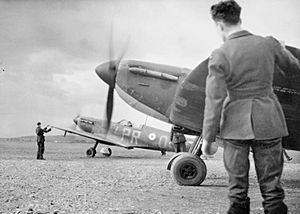John Curchin facts for kids
Quick facts for kids
John Curchin
|
|
|---|---|
| Born | 20 January 1918 Hawthorne, Victoria, Australia |
| Died | 4 June 1941 (aged 23) English Channel |
| Allegiance | Australia |
| Service/ |
Royal Air Force |
| Rank | Flight Lieutenant |
| Unit | No. 609 Squadron |
| Battles/wars | Second World War
|
| Awards | Distinguished Flying Cross |
John Curchin (born 18 January 1918 – died 4 June 1941) was a brave Australian pilot who became a "flying ace" during World War II. A flying ace is a pilot who has shot down five or more enemy aircraft. John flew for the Royal Air Force (RAF) and was known for shooting down at least eight enemy planes. He was even awarded the Distinguished Flying Cross for his courage.
John was born in Hawthorn, Australia, but later joined the RAF in 1939. He flew Supermarine Spitfire fighter planes, especially during the famous Battle of Britain. He achieved most of his victories during this important battle. Sadly, he went missing during a search and rescue mission over the English Channel in 1941.
Contents
Early Life and Joining the RAF
John Curchin was born on 18 January 1918 in Hawthorn, a town near Melbourne in Victoria, Australia. His parents were Henry Wallace Curchin and Susannah Curchin. Later, his family moved to the United Kingdom and settled in Enfield, near London.
John went to school at Merchant Taylor's School. In June 1939, he joined the Royal Air Force. After finishing his flight training in August, he became a pilot officer. He then went for more special training to prepare for flying in combat.
World War II Service
John Curchin officially became a pilot officer in April 1940. His first job was with No. 600 Squadron. This unit flew Bristol Blenheim planes, which were used as "night fighters" to find and attack enemy planes in the dark.
Soon after, on 11 June, John moved to No. 609 Squadron. This squadron was based at the same airfield, but they flew the fast and famous Supermarine Spitfire fighter planes. This squadron had just been very busy helping to protect the ships evacuating soldiers from Dunkirk in France.
Flying in the Battle of Britain
In July, John's squadron moved to a new base called Middle Wallop. From there, they protected important areas like Southampton and Portland. They also flew patrols over convoys of ships.
On 12 July, John and two other pilots attacked a German Heinkel He 111 bomber near Portland Bill. They thought they destroyed it, but it couldn't be confirmed. On 8 August, he successfully destroyed a Messerschmitt Bf 110 fighter plane near the Isle of Wight. He also damaged a Messerschmitt Bf 109 fighter that day. By the end of August, he shot down another Bf 109.
As the battle continued, John's squadron became more involved in the intense air fights over London. On 7 September, he destroyed a Bf 109 north of London. He also likely destroyed a Dornier Do 17 bomber on the same day. On 15 September, he helped shoot down two more Do 17s. He then shot down a Bf 109 on 24 September. The next day, he destroyed two Heinkel He 111 bombers over Bristol, and another one on 26 September.
Awarded for Bravery
By late October, the German air force, called the Luftwaffe, started to attack the UK less often. John Curchin ended the Battle of Britain with at least seven confirmed aerial victories. He was one of only six Australian "flying aces" in this battle.
For his amazing courage and skill, John was awarded the Distinguished Flying Cross (DFC). This award is given to officers in the Royal Air Force for acts of bravery during air operations. The official announcement said he showed "great keenness and skill" and had destroyed at least seven enemy aircraft.
Channel Front Operations
After the Battle of Britain, John's squadron spent the winter at Warmwell. In February 1941, they moved to Biggin Hill. They were now flying the newer Spitfire Mk II planes. Their missions changed to attacking German-occupied France.
On 6 April, John was promoted to flying officer and became a flight commander, leading a group of planes. On 8 May, he shot down a Bf 109 over the English Channel. He also helped destroy another Bf 109 that day.
Final Mission and Legacy
On 4 June 1941, John's squadron was on a search and rescue mission. They were looking for another pilot who had crashed into the English Channel. During this search, German Bf 109 fighters attacked John's Spitfires. John Curchin did not return from this fight. It is believed he was shot down and killed.
At the time of his death, John Curchin was a flight lieutenant. He was credited with destroying eight enemy aircraft, helping to destroy four others, probably destroying one, damaging one, and sharing in one unconfirmed destruction.
Since John Curchin has no known grave, his name is remembered on the Runnymede Memorial in England. As an Australian who died serving the United Kingdom, his name is also on the commemorative roll at the Australian War Memorial in Canberra, Australia.


